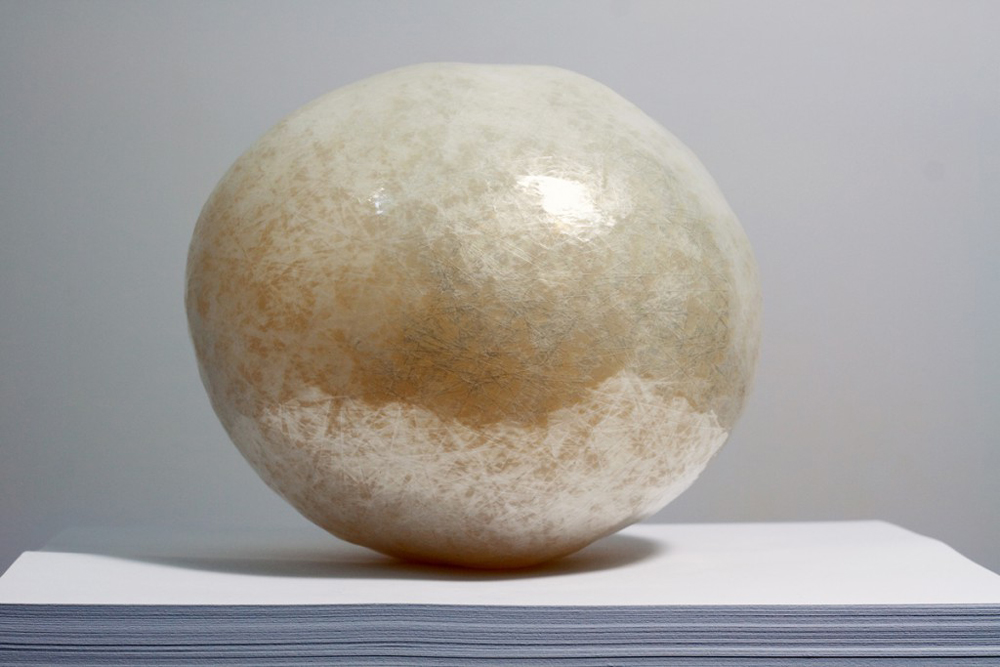In a show at Georgia Scherman Projects, eight works by Hyang Cho amount to “Nothing Much.” It’s an unassuming title for an exhibition held at a commercial gallery, self-effacing and bashfully dismissive of the works’ potential marketability. At first glance, each work appears simple and straightforward. It’s almost as if Cho has ferreted inspiration for her materials from that “thing drawer” we all have—that place we stow errant paperclips and business cards for safekeeping, tossing sentimental scraps that we can’t bear to part with in with “useful” odds and ends to store in case one day we need a solitary chopstick, or find the pen that belongs to that missing cap. You can tell a lot about a person by what they keep in their thing drawer.
The materials are modest, but the careful precision evident in the laborious process of making each of these works has transformed a drawer of real things into a chest of imagined treasures. Some works deal with personal memories and involve objects closely associated with Cho’s maternal lineage. In other works, Cho brings to mind Walter Benjamin’s Untidy Child in One-Way Street, whose drawers are “full of prickly chestnuts that are spiky clubs, tinfoil that is hoarded silver, bricks that are coffins, cacti that are totem-poles and copper pennies that are shields.” Ordinary materials are looked at with innocent wonderment and lent reverence.
On the wall, there is a string of colourful buttons, some of which used to belong to Cho’s mother, arranged in size from small to slightly less small, and on a slim plinth, there sits a small metal box containing index cards imprinted with the first names of every person Cho remembers having met since moving to Canada. A few empty cards are included to represent those she might have forgotten to remember.
On a plain wooden bench, where you can sit and a watch a slideshow of 61 mass-produced jars that the artist collected, finished the contents of, removed the labels from and cleaned, there are two blank paperbacks that are in fact bound blank pages carefully snipped out of other books. Another video shows 40 minutes of the artist spinning old cotton, which is connected to a sheet of white paper marked with “spinning spots,” as well as a large, porridge-coloured textile made of thread spun from cotton bedding that was handed down from grandmother to mother to daughter. On the floor, atop a stack of blank newsprint papers, a large pearlescent ball, made from folding and wrapping exactly 98 rolls of cellotape, resembles a lustrous ostrich egg.
Cho’s works are precise, but not slick. By running her practice as a labour-intensive industrial operation, Cho has in effect made sure that her sole occupation is that of an artist—nothing more. She’s reclaiming artisthood in an age where artists (and all people) are expected to also be businesspeople and brand managers. In an artistic climate where measures of value are assigned more often by collector than critic, and where studios resembling factories often handle administrative duties previously expected to belong to an artist’s dealer, making humble work that is labour-intensive enough so that there just isn’t time spare to assume another function is quietly rebellious and delightfully anti-capitalist. These works don’t cheekily engage with or filter ephemeral pop culture, and ersatz symbols of money and privilege are absent. Exploitative patronage is a practical impossibility when the most assertive sentence in an exhibition’s press release is that “plain things remain as plain, void is filled with another void, and time is passing as usual.”
Cho’s handiwork is particular, and the repetitive, mundane effort that has gone into the making of each piece is immediately visible. Immaterial weight is loaded onto each work by way of personal associations that are uniquely the artist’s, but are also ubiquitous and universally transferable. The finished products feel earnestly valuable, and stray only as far from their source material as her emotional responses allow. There’s no deceit or superfluity, so there’s nothing much, and it all turns out to amount to something of genuine substance.









